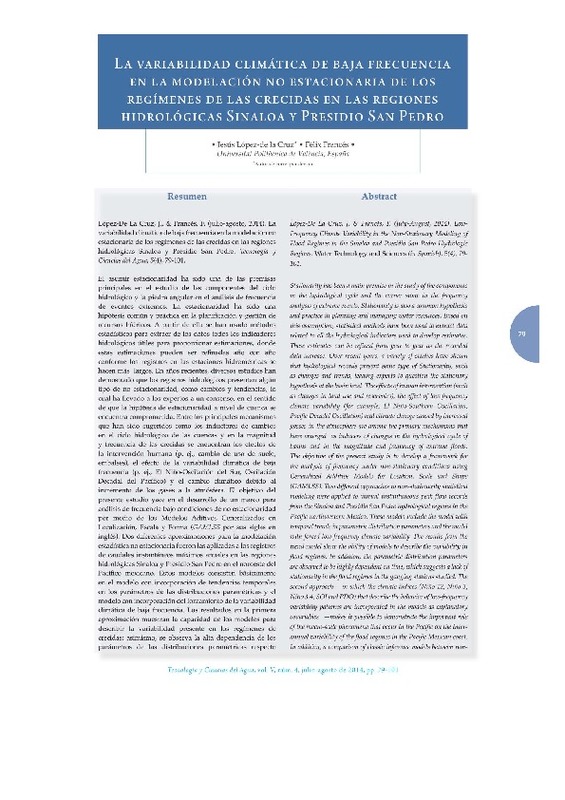JavaScript is disabled for your browser. Some features of this site may not work without it.
Buscar en RiuNet
Listar
Mi cuenta
Estadísticas
Ayuda RiuNet
Admin. UPV
La variabilidad climática en la modelación de la frecuencia de crecidas en las regiones hidrológicas de Sinaloa y Presidio San Pedro
Mostrar el registro sencillo del ítem
Ficheros en el ítem
| dc.contributor.author | López de la Cruz, Jesús
|
es_ES |
| dc.contributor.author | Francés García, Félix Ramón
|
es_ES |
| dc.date.accessioned | 2015-12-21T11:54:08Z | |
| dc.date.available | 2015-12-21T11:54:08Z | |
| dc.date.issued | 2014 | |
| dc.identifier.issn | 0187-8336 | |
| dc.identifier.uri | http://hdl.handle.net/10251/59091 | |
| dc.description.abstract | [EN] Stationarity has been a main premise in the study of the components in the hydrological cycle and the corner stone in the frequency analysis of extreme events. Stationarity is also a common hypothesis and practice in planning and managing water resources. Based on this assumption, statistical methods have been used to extract data related to all the hydrological indicators used to develop estimates. These estimates can be refined from year to year as the recorded data increase. Over recent years, a variety of studies have shown that hydrological records present some type of Stationarity, such as changes and trends, leading experts to question the stationary hypothesis at the basin level. The effects of human intervention (such as changes in land use and reservoirs), the effect of low-frequency climate variability (for example, El Nino-Southern Oscillation, Pacific Decadal Oscillation) and climate change caused by increased gasses in the atmosphere are among the primary mechanisms that have emerged as inducers of changes in the hydrological cycle of basins and in the magnitude and frequency of extreme floods. The objective of the present study is to develop a framework for the analysis of frequency under non-stationary conditions using Generalized Additive Models for Location, Scale and Shape (GAMLSS). Two different approaches to non-stationarity statistical modeling were applied to annual instantaneous peak flow records from the Sinaloa and Presidio San Pedro hydrological regions in the Pacific northwestern Mexico. These models include the model with temporal trends in parametric distribution parameters and the model with forced low-frequency climate variability. The results from the trend model show the ability of models to describe the variability in flood regimes. In addition, the parametric distribution parameters are observed to be highly dependent on time, which suggests a lack of stationarity in the flood regimes in the gauging stations studied. The second approach- in which the climate indices (Nino 12, Nino 3, Nino 3.4, SOI and PDO) that describe the behavior of low-frequency variability patterns are incorporated in the models as explanatory covariables -makes it possible to demonstrate the important role of the macro-scale phenomena that occur in the Pacific on the inter-annual variability of the flood regimes in the Pacific Mexican coast. In addition, a comparison of classic inference models between non-stationary and stationary quantiles shows that differences between stationarity and non-stationarity assumptions can be significant over long periods of time. | es_ES |
| dc.language | Español | es_ES |
| dc.publisher | Instituto Mexicano de Tecnología del Agua | es_ES |
| dc.relation.ispartof | Tecnología y Ciencias del Agua | es_ES |
| dc.rights | Reserva de todos los derechos | es_ES |
| dc.subject | Flood frequency analysis | es_ES |
| dc.subject | Annual peak flows | es_ES |
| dc.subject | GAMLSS | es_ES |
| dc.subject | Low-frequency climate variability patterns | es_ES |
| dc.subject | Mexican Pacific | es_ES |
| dc.subject | Non-stationarity | es_ES |
| dc.subject.classification | INGENIERIA HIDRAULICA | es_ES |
| dc.title | La variabilidad climática en la modelación de la frecuencia de crecidas en las regiones hidrológicas de Sinaloa y Presidio San Pedro | es_ES |
| dc.type | Artículo | es_ES |
| dc.rights.accessRights | Abierto | es_ES |
| dc.contributor.affiliation | Universitat Politècnica de València. Departamento de Ingeniería Hidráulica y Medio Ambiente - Departament d'Enginyeria Hidràulica i Medi Ambient | es_ES |
| dc.description.bibliographicCitation | López De La Cruz, J.; Francés García, FR. (2014). La variabilidad climática en la modelación de la frecuencia de crecidas en las regiones hidrológicas de Sinaloa y Presidio San Pedro. Tecnología y Ciencias del Agua. 5(4):79-101. http://hdl.handle.net/10251/59091 | es_ES |
| dc.description.accrualMethod | S | es_ES |
| dc.relation.publisherversion | https://www.imta.gob.mx/tyca/ | es_ES |
| dc.description.upvformatpinicio | 79 | es_ES |
| dc.description.upvformatpfin | 101 | es_ES |
| dc.type.version | info:eu-repo/semantics/publishedVersion | es_ES |
| dc.description.volume | 5 | es_ES |
| dc.description.issue | 4 | es_ES |
| dc.relation.senia | 287166 | es_ES |
| dc.identifier.eissn | 2007-2422 |






